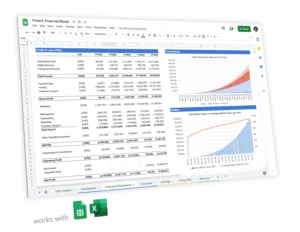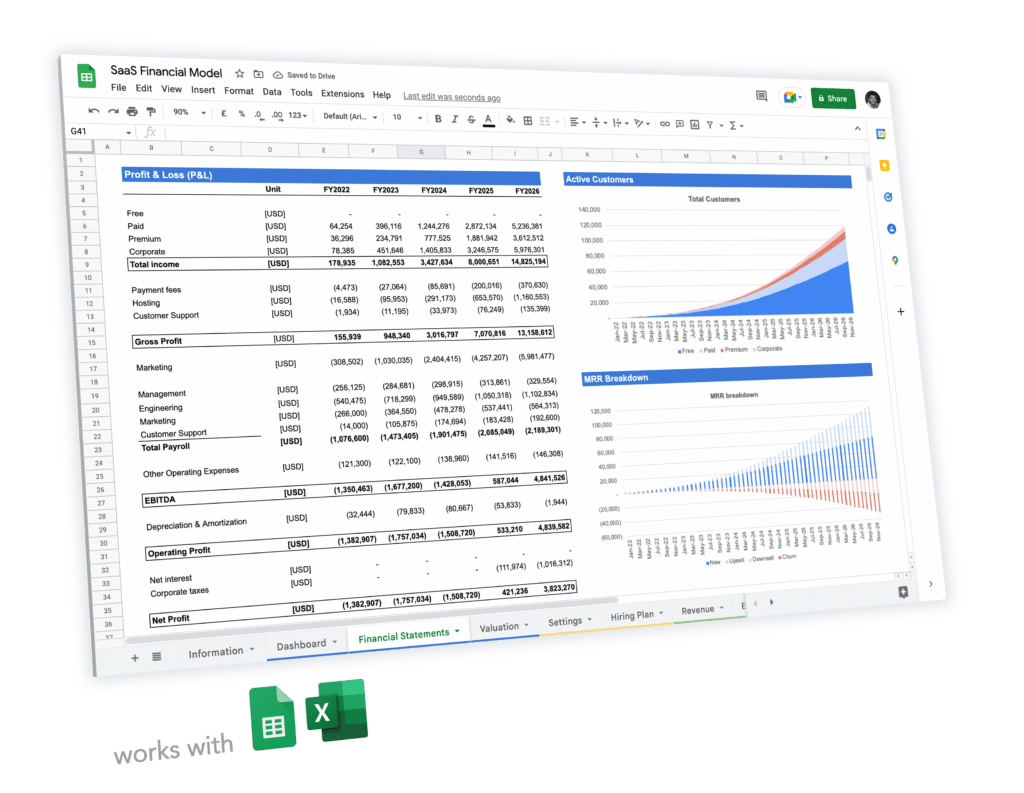With more than 2,400 deals and $98 billion invested in H1 2021, FinTech is (still) undeniably one of the hottest sector in Tech right now. From payments to insurtech to blockchain and cybersecurity, FinTech encompasses many ever-evolving segments creating countless opportunities for growth.
Due to strong underlying market trends, the Fintech industry has some of highest tech valuations out there: whilst we found a 7.5x average 2022 EV/Revenue multiple, some companies are even valued at 21x today ..!
Whether you’re looking for a valuation, as a founder or an investor, you’re at the right place. In this article we’ll go through a step-by-step valuation guide that works for any Fintech startup.
And to do so, we are using the most common valuation methodology for startups: the Venture Capital method. Also, we’re using publicly-available comparable companies in the Fintech industry so you can follow along, and do the same for your startup.
Note: if you’re looking for a financial model for your fintech startup instead, make sure to see our complete tutorial on how to use our Fintech financial model template.
Fintech Startup Valuation: Methodology
There are a number of startup valuation methodologies. Although none of them are perfect (as explained in our article here), they all try to calculate a valuation for a business given a number of both quantitative and qualitative factors. By far the most common methodology venture capital firms and investors worldwide use to value startups, including Fintech startups, is the Venture Capital Valuation Method (the “VC method”).
Indeed, the VC valuation method solves an important problem: unlike other methodologies the VC method takes into consideration business, market and investor-specific factors. Let’s see how.
Why Should You Use The Venture Capital Method?
A startup valuation (and its valuation multiple) is driven by a number of factors which can be grouped in 4 main categories. All of them are business, market or investor-specific, they are:
Product market fit & traction
A startup is more valuable if it can prove investors it already found early adopters for your product (product-market-fit), or even better: it already generate revenues
Team & execution track record
A startup valuation is higher if the founding team has a successful track record
Market
Your startup will be more valuable if your market is large and/or highly fragmented and/or growing at double digits
Investor’s appetite and bargaining power
Above all else, investors value startups so they can make a (substantial) profit in the future. If a startup is deemed too expensive, no investors will invest. Same goes with bargaining power: the more term sheets a founder receives from investors, the higher the valuation
How Does The VC Method Work?
The VC valuation method allows anyone to estimate a startup’s valuation by using 3 main drivers:
1. Expected revenues (business specific)
Expected revenues are usually 5-year revenue projections, meaning the startup expected revenues in 5 years time. Although startup financial projections obviously come with their grain of salt, we wrote extensively on the best practices to build realistic revenue projections for your startup.
By definition, (realistic) revenue projections are a direct function of the business (and by extension product market fit & traction and team & execution track record).
2. Industry valuation multiples (market specific)
Industry valuation multiples are revenue multiples (EV/Revenue for “Enterprise Value”) of comparable companies within the same industry. Scroll down below for 2022 Fintech companies’ valuation multiples.
Naturally, industry valuation multiples are a direct function of the market landscape.
3. Investors’ IRR (investor specific)
Investors’ IRR (“Internal Rate of Return”) is a required return on investment that varies between investors and the stage of investment. The higher the risk, the higher the required IRR. For example, an investor would require a higher IRR for an early stage deal such as a seed round vs. a Series A or Series B round.
Naturally, investors’ (required) IRR is investor-specific.
Fintech Startup Valuation: Example
Now that we’ve covered what the Venture Capital valuation method is, and how it works, let’s now see how to use it to value a Fintech startup.
1. Expected Revenues
The first thing to do is to forecast your startup (or the startup you’re trying to value) over 5 years. No need to go into much depth when it comes to expenses and cash flow as we will only look at projected revenues here.
For more information on how to create realistic revenue projections for your startup, see our article here, or check out our expert-built financial model templates below to save time & effort.
So now let's assume that, for the purpose of the VC valuation method, we're projecting the financials of a Fintech startup and we forecast 5-year revenues at $60 million.
2. Valuation multiples
Looking at the Fintech startups out there, we can find 15 publicly-listed company comparables.
Although sometimes very different, their respective valuation multiple is the result of their business model, revenue growth and profitability.
Important: To keep things simple, and for the purpose of this article, we are using these 15 companies to derive the Revenue valuation multiple we will use as part of the VC valuation method. Naturally, when calculating your startup valuation, you must select the comparables that make more sense to the company's specifics and not the entire group.
| Company | EV ($M) | LTM Revenue ($M) | EV/Revenue |
|---|---|---|---|
| Affirm Holdings, Inc. | 11,439 | 1,123 | 10.2x |
| Coinbase Global, Inc. | 37,334 | 7,839 | 4.8x |
| Ebix, Inc. | 1,595 | 995 | 1.6x |
| Fidelity National Information Services, Inc. | 80,740 | 13,877 | 5.8x |
| Fiserv, Inc. | 84,682 | 16,226 | 5.2x |
| Global Payments Inc. | 48,991 | 8,524 | 5.7x |
| Guidewire Software, Inc. | 7,833 | 739 | 10.6x |
| Robinhood Markets, Inc. | 3,683 | 1,815 | 2.0x |
| Jack Henry & Associates, Inc. | 14,651 | 1,866 | 7.9x |
| Metromile, Inc. | 37 | 102 | 0.4x |
| MeridianLink, Inc. | 1,914 | 132 | 14.5x |
| MSCI Inc. | 42,977 | 2,044 | 21.0x |
| Verisk Analytics, Inc. | 37,862 | 2,999 | 12.6x |
| Vertex Energy, Inc. | 606 | 183 | 3.3x |
| Workiva Inc. | 5,850 | 443 | 13.2x |
| Median | 5.8x | ||
| Average | 7.9x |
For the purpose of the VC valuation method, we will use the median EV/Revenue multiple of 5.8x, that we will further adjust for the Discount of Lack of Marketability (DLOM) of 25%. So we finally obtain an adjusted EV/Revenue multiple of 4.7x.
3. Investors’ IRR
Investors’ required IRR vary by investors, the stage they’re investing in (early-stage deals tend to require higher IRR vs. later stage deals) and the industry naturally.
According to a recent study, the average IRR for venture capital firms was 19.8%. Yet, this percentage is an average: it also takes into account failed deals (the ones that go wrong). Indeed, VCs typically hope to realise anywhere between 40-60% IRR on the deals they invest in. Again, this is a high-level average, and depends on a number of factors as explained earlier.
For the purpose of our analysis, we'll use 40-60% IRR as a low-end, high-end valuation range.
4. Wrapping Up
As per the VC valuation method, first we need to calculate the exit value: the valuation of the company when VCs are expected to sell their stake (by default here 5 years).
Exit Value = EV/Revenue x Revenue at exit (5 years)
Exit Value = 4.7x x $60M
Exit Value = $280M
Now, assuming we are looking at a Series A startup, we therefore assume investors will require a 40-50% IRR over the next 5 years. Indeed, understanding the stage of the startup we are trying to value (whether Seed, Series A or B) allow us to accurately estimate the required IRR. For example, a Seed startup could be valued using 50-60% IRR, whilst a Series A startup would instead use 40-50%.
Now we must discount the exit value to obtain the post-money valuation as shown below:
Post-money valuation = Exit value / (1 + IRR)^5
$280M / (1 + 50%)^5 < Post-money valuation < $280M / (1 + 40%)^5
$37M < Post-money valuation < $52M
This means this startup could reasonably be valued today at a pre-money valuation of $37 to $52 million (for more information on what is pre and post money valuation, see our article here).
Finally, although the exit value is calculated with a 4.7x multiple (from publicly-listed Fintech comparable companies), the current startup valuation logically result in a different (higher) multiple. Indeed, the $37-52M valuation results in a EV/NTM Revenue multiple of ~7-10x using the NTM revenue of $5M as shown earlier (NTM for “next-twelve-months”).




 5-year pro forma financial model
5-year pro forma financial model 20+ charts and business valuation
20+ charts and business valuation  Free support
Free support